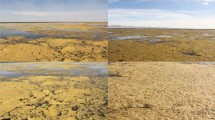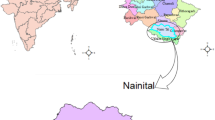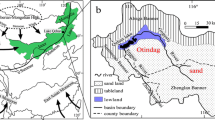Abstract
The increasingly serious harmful algal blooms (HABs) in Taihu Lake has brought huge losses to the local economy and people’s life in Taihu Lake. Satellite remote sensing technology has become one of the most important monitoring methods for HAB disasters due to its large-scale and long-term advantages. GOCI image has become the new data source of HAB monitoring because of its large size and high time resolution. Due to the low spatial resolution (500 m) and the existence of mixed pixels, the error of HAB area obtained by the NDVI method is large. In this paper, the linear mixing model (LMM) and the normalized difference vegetation index (NDVI) threshold method are combined to extract the HAB area from GOCI images with 500-m spatial resolution. Compared with the results of the HAB area extracted by Landsat8 OLI and MODIS data, three small areas in the study area were selected to verify the accuracy of the HAB area extracted from the GOCI image on October 2, 2015. The results show that when the NDVI threshold is 0.1, the area error of HABs is the smallest when the extracted HAB pixels mask the decomposition results of mixed pixels; besides, the area error of HABs extracted from the GOCI image is smaller than that from MODIS image; finally, GOCI image can extract the spatial dynamic distribution of HABs in Taihu Lake within 8 h a day, which has higher temporal resolution than the MODIS image. Compared with the NDVI threshold method and LMM method, the inversion accuracy is greatly improved, and the accuracy is stable in different regions. It can provide technical support for the decision-making and assessment of HAB ecological disasters.







Similar content being viewed by others
Data Availability
Data sharing is not applicable to this article as no datasets were generated or analyzed during the current study.
References
Ahn JH, Park YJ, Ryu JH, Lee B, Oh IS (2012) Development of atmospheric correction algorithm for Geostationary Ocean Color Imager (GOCI). Ocean Sci J 47:247–259
Bonansea M, Ledesma C, Rodríguez C, Pinotti L, Antunes MH (2015) Effects of atmospheric correction of Landsat imagery on lake water clarity assessment. Adv Space Res 56:2345–2355
Cannizzaro JP, Barnes BB, Hu CM, Corcoran AA, Hubbard KA, Muhlbach E, Sharp WC, Brand LE, Kelble CR (2019) Remote detection of cyanobacteria blooms in an optically shallow subtropical lagoonal estuary using MODIS data. Remote Sens Environ 231:111227
Cao HS (2006) Study on the formation process and dominant ecological factors of cyanobacteria bloom in Taihu, Nanjing Institute of Geography & Limnology. Chinese Academy of Sciences, Nanjing
Cao RY, Chen Y, Shen MG, Chen J, Zhou J, Wang C, Yang W (2018) A simple method to improve the quality of NDVI time-series data by integrating spatiotemporal information with the Savitzky-Golay filter. Remote Sens Environ 217:244–257
Chen XR, Shang SL, Lee ZP, Qi L, Yan J, Li YH (2019) High-frequency observation of floating algae from AHI on Himawari-8. Remote Sens Environ 227:151–161
Cho M, Ramoelo A (2019) Optimal dates for assessing long-term changes in tree-cover in the semi-arid biomes of South Africa using MODIS NDVI time series (2001–2018). Int J Appl Earth Obs Geoinf 81:27–36
Chorus EI, Bartram J (1999) Toxic cyanobacteria in water: a guide to their public health consequences, monitoring and management. E & FN Spon, London, p 17
Diaz R, Rosenberg R (2008) Spreading dead zones and consequences for marine ecosystems. Science 321:926–929
Du CG, Li YM, Wang Q, Liu G, Zheng ZB, Mu M, Li Y (2017) Tempo-spatial dynamics of water quality and its response to river flow in estuary of Taihu Lake based on GOCI imagery. Environ Sci Pollut Res 24:28079–28101
Duan HT, Zhang SX, Zhang YZ (2008) Cyanobaeteria bloom monitoring with remote sensing in Lake Taihu. J Lake Sci 20:145–152
Duan HT, Ma RH, Hu CM (2012) Evaluation of remote sensing algorithms for cyanobacterial pigment retrievals during spring bloom formation in several lakes of East China. Remote Sens Environ 126:126–135
Foster R, Kuypers M, Vagner T, Paerl R, Musat N, Zehr J (2011) Nitrogen fixation and transfer in open ocean diatom-cyanobacterial symbioses. ISME J 5:1484–1493
Fu KZ, Moe B, Li XF, Le XC (2015) Cyanobacterial bloom dynamics in Lake Taihu. J Environ Sci (China) 32:249–251
Glibert P, Heil C, Hollander D, Revilla M, Hoare A, Alexander J, Murasko S (2004) Evidence for dissolved organic nitrogen and phosphorus uptake during a cyanobacterial bloom in Florida Bay. Mar Ecol Prog Ser 280:73–83
Gu XF, Chen XF, Yin Q, Xu H, Shao Y, Li ZW (2011) Stereoscopic remote sensing used in monitoring Enteromorpha prolifera disaster in Chinese Yellow Sea. Spectrosc Spectr Anal 31:1627–1632
Guo L (2007) Doing battle with the green monster of Taihu Lake. Science 317:1166
Higa H, Sugahara S, Salem SL, Nakamura Y, Suzuki T (2020) An estimation method for blue tide distribution in Tokyo Bay based on sulfur concentrations using Geostationary Ocean Color Imager (GOCI). Estuar Coast Shelf Sci 235:106615
Hu YK, Yu ZF, Zhou B, Li Y, Yin SJ, He XQ, Peng XX, Shum CK (2019) Tidal-driven variation of suspended sediment in Hangzhou Bay based on GOCI data. Int J Appl Earth Obs Geoinf 82:101920
Huang CC, Guo YL, Yang H, Zou J, Zhang ML, Lyu H, Zhu AX, Huang T (2015) Using remote sensing to track variation in phosphorus and its interaction with chlorophyll-a and suspended sediment. IEEE J Sel Top Appl Earth Obs Remote Sens 8:1–11
Huisman J, Matthijs HC, Visser PM (2005) Harmful cyanobacteria. Aquatic Ecology Series. Springer, Dordrecht
Jiang GJ, Ma RH, Loiselle S, Su W, Cai WX, Huang CG, Yang J, Yu W (2015) Remote sensing of particulate organic carbon dynamics in a eutrophic lake (Taihu Lake, China). Sci Total Environ 532:245–254
Kim S, Duan R, Ma GQ, Kim HY (2020) Multiresolution spatial generalized linear mixed model for integrating multi-fidelity spatial count data without common identifiers between data sources. Spat Stat 39:100467
Kong FX, Gao G (2005) Hypothesis on cyanobacteria bloom-forming mechanism in large shallow eutrophic lakes. Acta Ecol Sin 25:589–595
Kwon YS, Pyo JC, Kwon YH, Duan HT, Cho KH, Park Y (2020) Drone-based hyperspectral remote sensing of cyanobacteria using vertical cumulative pigment concentration in a deep reservoir. Remote Sens Environ 236:111517
Lei SH, Xu J, Li YM, Du CG, Liu G, Zheng ZB, Xu YF, Lyu H, Mu M, Miao S, Zeng S, Xu JF, Li LL (2020) An approach for retrieval of horizontal and vertical distribution of total suspended matter concentration from GOCI data over Lake Hongze. Sci Total Environ 700:134524
Li Y, Shang SL, Zhang CY, Ma XX, Huang LW, Wu JY, Zeng YD (2005) Recognition model of algal bloom water based on the relationship between visible light and near infrared remote sensing reflectance Chin. Sci Bull 50:2555–2561
Lips I, Lips U, Leppänen JM (2003) The influence of weather conditions (temperature and wind) on cyanobacterial bloom development in the Gulf of Finland (Baltic Sea). Harmful Algae 2:29–41
Liu JG, Yang W (2012) Water sustainability for China and beyond. Science 337:649–650
Luo JH, Li XC, Ma RH, Li F, Duan HT, Hu WP, Qin BQ, Huang WJ (2016) Applying remote sensing techniques to monitoring seasonal and interannual changes of aquatic vegetation in Taihu Lake. China. Ecol Indic 60:503–513
Luo JH, Pu RL, Duan HT, Ma RH, Mao ZG, Zeng Y, Huang LS, Xiao QT (2020) Evaluating the influences of harvesting activity and eutrophication on loss of aquatic vegetations in Taihu Lake, China. Int J Appl Earth Obs Geoinf 87:102038
Lv CC, Wang ZW, Qian SM (2003) A Review of Pixel Unmixing Models. Remote Sens Inform 3:55–60
Lyit N, Genc A (2011) Constitution of random intercept and slope model (RISM) as a special case of linear mixed models (LMMs) for repeated measurements data. Appl Math Comput 218:827–831
Ma JG, Duan HT, He LY, Tiffany M, Cao ZG, Qi TC, Shen M, Biggs T, Xu XF (2020) Spatiotemporal pattern of gypsum blooms in the Salton Sea, California, during 2000-2018. Int J Appl Earth Obs Geoinf 89:102090
Ma JH, Song KS, Shao TT, Zhao Y, Wen ZD (2016) Comparison of water transparency retrieving of lakes in the mid-east part of Jilin Province based on HJ-CCD and MODIS imagery. J Lake Sci 28:661–668
Ma RH, Kong FX, Duan HT, Zhang SX, Kong WJ, Hao JY (2008) Spatio-temporal distribution of cyanobacteria blooms based on satellite imageries in Lake Taihu, China. J Lake Sci 20:687–694
Ma RH, Kong WJ, Duan HT, Zhang SX (2009) Quantitative estimation of phycocyanin concentration using MODIS imagery during the period of cyanobacterial blooming in Taihu Lake, China. Environ Sci 29:254–260
Meng QM, Cieszewski CJ, Madden M, Borders B (2007) A linear mixed-effects model of biomass and volume of trees using Landsat ETM+ images. For Ecol Manag 244:93–101
Micheli F (1999) Eutrophication, fisheries, and consumer-resource dynamics in marine pelagic ecosystems. Science 285:1396–1398
Nazeer M, Wong MS, Nichol JE (2017) A new approach for the estimation of phytoplankton cell counts associated with algal blooms. Sci Total Environ 590-591:125–138
Noh JH, Kim W, Son SH, Ahn JH, Park YJ (2018) Remote quantification of Cochlodinium polykrikoides blooms occurring in the East Sea using geostationary ocean color imager (GOCI). Harmful Algae 73:129–137
Norris JR, Walker JJ (2020) Solar and sensor geometry, not vegetation response, drive satellite NDVI phenology in widespread ecosystems of the western United States. Remote Sens Environ 249:112013
Oyama Y, Matsushita B, Fukushima T (2015) Distinguishing surface cyanobacterial blooms and aquatic macrophytes using Landsat/TM and ETM+ shortwave infrared bands. Remote Sens Environ 157:35–47
Pal M, Yesankar PJ, Dwivedi A, Qureshi A (2020) Biotic control of harmful algal blooms (HABs): a brief review. J Environ Manag 268:110687
Pang JM, Liu ZQ, Wang XM, Bresch J, Ban JM, Chen D, Kim J (2018) Assimilating AOD retrievals from GOCI and VIIRS to forecast surface PM 2.5 episodes over Eastern China. Atmos Environ 179:288–304
Qi L, Hu CM, Duan HT, Cannizzaro J, Ma RH (2014) A novel MERIS algorithm to derive cyanobacterial phycocyanin pigment concentrations in a eutrophic lake: theoretical basis and practical considerations. Remote Sens Environ 154:298–317
Qin BQ, Zhu GW, Gao G, Zhang YL, Li W, Paerl HW, Carmichael WW (2010) A drinking water crisis in Lake Taihu, China: linkage to climatic variability and lake management. Environ Manag 45:105–112
Qin BQ, Yang GJ, Ma JR, Deng JM, Li W, Wu TF, Liu LZ, Gao G, Zhu GW, Zhang YL (2016) Dynamics of variability and mechanism of harmful cyanobacteria bloom in Lake Taihu, China. Chin Sci Bull 61:759–770
Reichwaldt E, Ghadouani A (2011) Effects of rainfall patterns on toxic cyanobacterial blooms in a changing climate: between simplistic scenarios and complex dynamics. Water Res 46:1372–1393
Shi K, Zhang YL, Qin BQ, Zhou BT (2019) Remote sensing of cyanobacterial blooms in inland waters: present knowledge and future challenges. Sci Bull 64:1540–1556
Tang D, Liu DR, Tang YL, Seyler B, Deng XF, Zhan Y (2019) Comparison of GOCI and Himawari-8 aerosol optical depth for deriving full-coverage hourly PM2.5 across the Yangtze River Delta. Atmos Environ 217:116973
Vonlanthen P, Bittner D, Hudson A, Young K, Müller R, Lundsgaard-Hansen B, Roy D, Piazza S, Largiader C, Seehausen O (2012) Eutrophication causes speciation reversal in whitefish adaptive radiations. Nature 482:357–362
Wang D, Ma RH, Xue K, Loiselle S (2019a) The assessment of Landsat-8 OLI atmospheric correction Algorithms for inland waters. Remote Sens 11:169
Wang FJ, Sheng H, Su J, Min XF (2018) Refined extraction method for green tide coverage area based on GOCI data. J Geom 43:24–27
Wang JH, Yang C, He LQS, Dao GH, Du JS, Han YP, Wu GX, Wu QY, Hu HY (2019b) Meteorological factors and water quality changes of Plateau Lake Dianchi in China (1990–2015) and their joint influences on cyanobacterial blooms. Sci Total Environ 665:406–418
Wang JH, Wang YN, Dao GH, Du JS, Han YP, Hu HY (2020) Decade-long meteorological and water quality dynamics of northern Lake Dianchi and recommendations on algal bloom mitigation via key influencing factors identification. Ecol Indic 115:106425
Warren-Rhodes KA, Rhodes KL, Boyle LN, Pointing SB, Chen Y, Liu SJ, Zhuo PJ, McKay CP (2007) Cyanobacterial ecology across environmental gradients and spatial scales in China’s hot and cold deserts. FEMS Microbiol Ecol 61:470–482
Wu TF, Zhu GW, Qin BQ, Ding YQ, Wu SF (2012) Prior wind field induced hydrodynamics and its influence on cyanobacterial bloom in northern bays of Lake Taihu. China. J Lake Sci 24:409–415
Wu TF, Qin BQ, Zhu GW, Luo LC, Ding YQ, Bian GY (2013) Dynamics of cyanobacteria bloom formation during short-term hydrodynamic fluctuation in a large shallow, eutrophic, and wind-exposed Lake Taihu. China. Environ Sci Pollut Res Int 20:8546–8556
Wynne TT, Stumpf RP, Tomlinson MC, Dyble J (2010) Characterizing a cyanobacterial bloom in Western Lake Erie using satellite imagery and meteorological data. Limnol Oceanogr 55:2025–2036
Xie GJ, Tang XM, Shao KQ, Hu Y, Liu H, Martin RM, Gao G (2020) Spatiotemporal patterns and environmental drivers of total and active bacterial abundances in Lake Taihu, China. Ecol Indic 114:106335
Xu JP, Zhang B, Li F, Song KS, Wang ZM (2008) Detecting modes of cyanobacteria bloom using MODIS data in Lake Taihu. J Lake Sci 20:191–195
Xue QJ, Steinman AD, Xie LQ, Yao L, Su XM, Cao Q, Zhao YY, Cai YJ (2020) Seasonal variation and potential risk assessment of microcystins in the sediments of Lake Taihu, China. Environ Pollut 259:113884
Yang Z, Zhang M, Shi XL, Kong FX, Ma RH, Yu Y (2016) Nutrient reduction magnifies the impact of extreme weather on cyanobacterial bloom formation in large shallow Lake Taihu (China). Water Res 103:302–310
Yao XL, Zhang YL, Zhang L, Zhu GW, Qin BQ, Zhou YQ, Xue JY (2020) Emerging role of dissolved organic nitrogen in supporting algal bloom persistence in Lake Taihu, China: emphasis on internal transformations. Sci Total Environ 736:139497
Yeom JM, Ko J, Kim HO (2015) Application of GOCI-derived vegetation index profiles to estimation of paddy rice yield using the GRAMI rice model. Comput Electron Agric 118:1–8
Yeom JM, Roujean JL, Han KS, Lee KS, Kim HW (2020) Thin cloud detection over land using background surface reflectance based on the BRDF model applied to Geostationary Ocean Color Imager (GOCI) satellite data sets. Remote Sens Environ 239:111610
Yu YF, Xing LX, Pan J, Jiang LJ, Yu HL (2016) Study of high temperature targets identification and temperature retrieval experimental model in SWIR remote sensing based Landsat8. Int J Appl Earth Obs Geoinf 46:56–62
Zhou LG, Feng XZ, Wang CH, Wang DY, Xu X (2008) Monitoring cyanobacteria bloom based on MODIS data in Lake Taihu. J Lake Sci 20:203–207
Zhu YC, Cai QM (1997) The Dynamic Research of The influence of Wind Field on The Migration of Algae in Taihu Lake. J Lake Sci 9:152–158
Acknowledgements
This research was supported by the Joint Funded Project of the Ministry of Education and the Ministry of Equipment Research and Development (Grant No. 6141A02022376), Open Fund of the Shaanxi Key Laboratory of Land Remediation (Grant No. 2018-ZY01), and Innovative Team Project of the Central University of Chang’an University for Basic Research and Business Expenses (Grant No. 300102350401). The authors would like to acknowledge the Leading Ocean Remote Sensing Research Activities in Korea for providing the GOCI images, the National Aeronautics and Space Administration for providing MODIS images, the US Geological Survey for providing Landsat8 OLI images, and the European Centre for Medium-Range Weather Forecasts for providing meteorological data. We’re also thankful for several anonymous reviewers for their help in improving this paper with their constructive suggestions.
Author information
Authors and Affiliations
Contributions
Hongye Cao is responsible for the conceptualization, methodology, software, validation, and visualization of this article, while Ling Han is responsible for funding acquisition and supervision.
Corresponding author
Ethics declarations
Ethics approval and consent to participate
Not applicable.
Consent for publication
All authors agree to have this manuscript published in this journal.
Competing interest
The authors declare no competing interests.
Additional information
Responsible editor: Philipp Gariguess
Publisher’s note
Springer Nature remains neutral with regard to jurisdictional claims in published maps and institutional affiliations.
Rights and permissions
About this article
Cite this article
Cao, H., Han, L. Hourly remote sensing monitoring of harmful algal blooms (HABs) in Taihu Lake based on GOCI images. Environ Sci Pollut Res 28, 35958–35970 (2021). https://doi.org/10.1007/s11356-021-13318-6
Received:
Accepted:
Published:
Issue Date:
DOI: https://doi.org/10.1007/s11356-021-13318-6




